-
 Bitcoin
Bitcoin $96,271.5649
1.52% -
 Ethereum
Ethereum $1,848.3676
3.31% -
 Tether USDt
Tether USDt $1.0004
0.02% -
 XRP
XRP $2.2363
0.59% -
 BNB
BNB $603.4539
0.30% -
 Solana
Solana $151.5205
3.30% -
 USDC
USDC $1.0000
0.03% -
 Dogecoin
Dogecoin $0.1789
2.90% -
 Cardano
Cardano $0.7063
1.42% -
 TRON
TRON $0.2488
1.36% -
 Sui
Sui $3.7029
6.22% -
 Chainlink
Chainlink $14.9337
3.04% -
 Avalanche
Avalanche $21.4174
0.05% -
 Stellar
Stellar $0.2784
0.99% -
 UNUS SED LEO
UNUS SED LEO $8.9307
-1.16% -
 Shiba Inu
Shiba Inu $0.0...01363
2.06% -
 Hedera
Hedera $0.1889
2.53% -
 Toncoin
Toncoin $3.1825
-1.74% -
 Bitcoin Cash
Bitcoin Cash $371.8028
1.17% -
 Hyperliquid
Hyperliquid $20.1811
8.08% -
 Litecoin
Litecoin $87.0421
3.05% -
 Polkadot
Polkadot $4.1687
1.30% -
 Dai
Dai $1.0002
0.02% -
 Bitget Token
Bitget Token $4.3849
-0.04% -
 Monero
Monero $270.3930
-0.13% -
 Ethena USDe
Ethena USDe $1.0005
0.10% -
 Pi
Pi $0.6126
5.97% -
 Pepe
Pepe $0.0...09014
0.15% -
 Aptos
Aptos $5.5381
2.82% -
 Uniswap
Uniswap $5.3495
0.48%
What should I do if the transaction fee of Stacks(STX) is too high? How to reduce the transaction cost?
To reduce high Stacks (STX) transaction fees, monitor network congestion, batch transactions, adjust priority, use fee-optimized wallets, and explore layer-2 solutions.
May 01, 2025 at 09:07 am
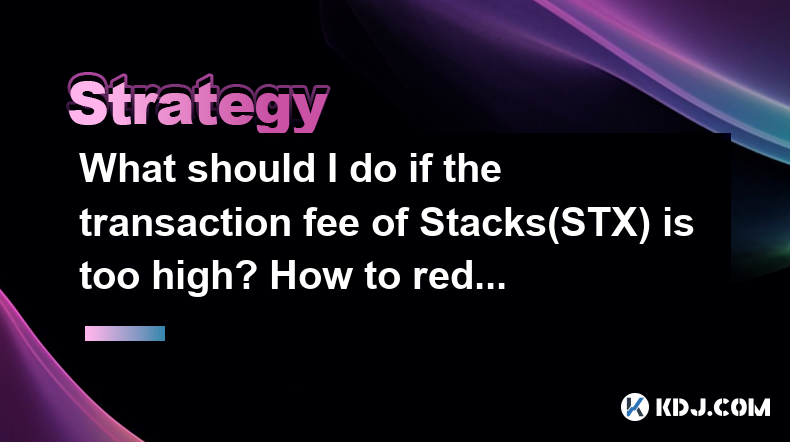
If you're finding that the transaction fees for Stacks (STX) are too high, there are several strategies you can employ to reduce your costs. Understanding the factors that influence these fees and learning how to manage them effectively can significantly lower your expenses. Let's delve into the details of how you can tackle high transaction fees on the Stacks blockchain.
Understanding Stacks Transaction Fees
Stacks (STX) operates as a layer-1 blockchain that is designed to enable smart contracts and decentralized applications (dApps) on Bitcoin. The transaction fees on Stacks are determined by several factors, including network congestion, the size of the transaction, and the priority you set for your transaction.
When the network is busy, miners prioritize transactions with higher fees, which can drive up the cost. The size of your transaction, measured in bytes, also affects the fee, as larger transactions require more space on the blockchain. Additionally, setting a higher priority for your transaction can result in faster processing but at a higher cost.
Strategies to Reduce Stacks Transaction Fees
There are several practical steps you can take to reduce the transaction fees when using Stacks. Here’s how you can go about it:
1. Choose the Right Time to Transact
One effective way to reduce fees is to monitor the network congestion. During periods of low activity, transaction fees tend to be lower. You can use blockchain explorers or analytics platforms to check the current state of the Stacks network.
- Visit a Stacks blockchain explorer like Hiro or Stacks Explorer.
- Look for the current transaction volume and fee estimates.
- Plan your transactions during times when the network is less congested.
2. Optimize Transaction Size
Reducing the size of your transaction can also help lower fees. This involves:
- Batching transactions: Instead of sending multiple small transactions, you can batch them into one larger transaction. This reduces the overall byte size and, consequently, the fee.
- Using SegWit addresses: If available, using SegWit addresses can reduce the size of your transaction, as they separate signature data from the transaction data.
3. Adjust Transaction Priority
You have the option to set the priority of your transaction, which influences the fee. Here's how to do it:
- Low priority: Choose a lower fee if you are not in a hurry. This can significantly reduce costs, though it may take longer for your transaction to be processed.
- Customize fees: Some wallets allow you to manually set the fee. Use fee estimation tools to find an optimal balance between cost and speed.
4. Use a Wallet with Fee Optimization Features
Selecting the right wallet can make a big difference in managing fees. Some wallets come with features designed to optimize transaction costs:
- Hiro Wallet: This wallet offers tools to estimate and adjust fees based on current network conditions.
- Xverse Wallet: Another option that provides fee optimization features, allowing you to choose the most cost-effective settings for your transactions.
To use these features:
- Download and install the wallet of your choice.
- When initiating a transaction, look for options to adjust the fee or see fee estimates.
- Select the lowest fee that still meets your time requirements.
5. Leverage Layer-2 Solutions
If available, layer-2 solutions can be an effective way to reduce transaction costs. These solutions operate on top of the main Stacks blockchain and can process transactions more efficiently and at a lower cost.
- Research available layer-2 solutions for Stacks.
- Follow the specific instructions provided by the layer-2 service to move your transactions off the main chain and back when necessary.
Practical Steps to Implement These Strategies
Let's go through some practical steps to implement the strategies mentioned above:
Monitoring Network Congestion:
- Open a Stacks blockchain explorer.
- Check the current transaction volume and fee estimates.
- Schedule your transactions during off-peak hours.
Batching Transactions:
- If you have multiple transactions to make, consolidate them into a single transaction.
- Use wallet features that support batching to streamline the process.
Adjusting Transaction Priority:
- Open your wallet and initiate a transaction.
- Look for options to adjust the fee or set a custom fee.
- Choose a lower fee if you can afford to wait longer for confirmation.
Using a Fee-Optimized Wallet:
- Download and install a wallet like Hiro or Xverse.
- When sending STX, use the wallet's fee optimization tools to find the best fee setting for your needs.
Exploring Layer-2 Solutions:
- Research any available layer-2 solutions for Stacks.
- Follow the specific steps provided by the layer-2 service to move your transactions off the main chain.
FAQs
Q: Can I get a refund if I accidentally set a high transaction fee on Stacks?
A: Unfortunately, once a transaction is broadcasted to the Stacks network, the fee cannot be refunded. It's important to double-check your fee settings before confirming a transaction.
Q: Are there any risks associated with using layer-2 solutions to reduce fees on Stacks?
A: While layer-2 solutions can significantly reduce fees, they may introduce additional risks such as smart contract vulnerabilities or liquidity issues. Always research and understand the risks before using any layer-2 service.
Q: How often do Stacks transaction fees fluctuate, and what causes these fluctuations?
A: Stacks transaction fees can fluctuate frequently, often on a daily or even hourly basis. The primary causes are changes in network congestion and the demand for block space. Monitoring these factors can help you predict fee changes and plan your transactions accordingly.
Q: Is it possible to predict when Stacks fees will be low?
A: While it's challenging to predict with absolute certainty, you can use historical data and current network activity to make educated guesses. Tools and platforms that provide real-time data on Stacks network congestion can help you find the best times for low-fee transactions.
Disclaimer:info@kdj.com
The information provided is not trading advice. kdj.com does not assume any responsibility for any investments made based on the information provided in this article. Cryptocurrencies are highly volatile and it is highly recommended that you invest with caution after thorough research!
If you believe that the content used on this website infringes your copyright, please contact us immediately (info@kdj.com) and we will delete it promptly.
- SUI Price Prediction—Will it Reach $10 in 2025?
- 2025-05-01 20:25:12
- Cryptocurrency market capitalization increased in the past 24 hours as markets reassessed the likelihood of a rate cut by the Fed
- 2025-05-01 20:25:12
- Binance De-Listing ALPACA Crypto – What Are The Accusations?
- 2025-05-01 20:20:12
- Whale Activity Fuels Cardano (ADA) Price Despite Stretched Resistance Levels
- 2025-05-01 20:20:12
- Four Crypto Tokens That Could Explode This May
- 2025-05-01 20:15:12
- Metaplanet — a Japanese company focused on accumulating Bitcoin — announced it will launch a United States-based subsidiary.
- 2025-05-01 20:15:12
Related knowledge
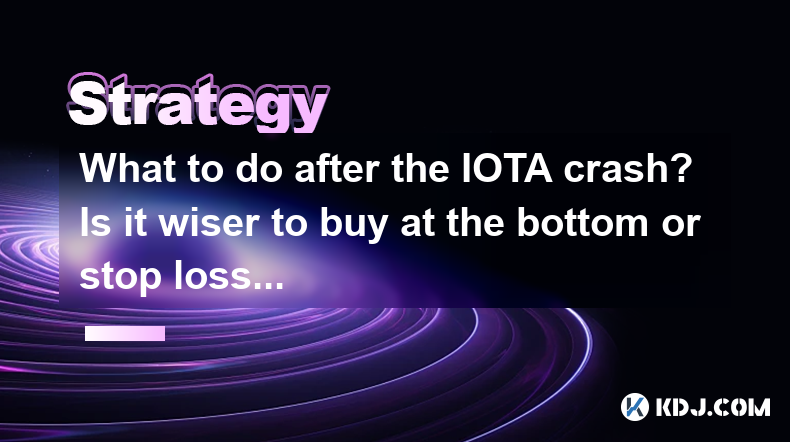
What to do after the IOTA crash? Is it wiser to buy at the bottom or stop loss?
May 01,2025 at 08:43am
After experiencing a significant crash in the value of IOTA, investors and traders are often left wondering about the best course of action. The decision to buy at the bottom or implement a stop loss can be pivotal, and understanding the nuances of each strategy is essential for making informed decisions. This article delves into the various approaches ...

Is the IOTA trading robot easy to use? How to set up an automated strategy?
Apr 30,2025 at 09:21pm
Is the IOTA trading robot easy to use? How to set up an automated strategy? The world of cryptocurrency trading has seen significant advancements in automation, and one such tool is the IOTA trading robot. Many traders are curious about the ease of use of these robots and how to set up an automated strategy. This article will delve into these topics, pr...
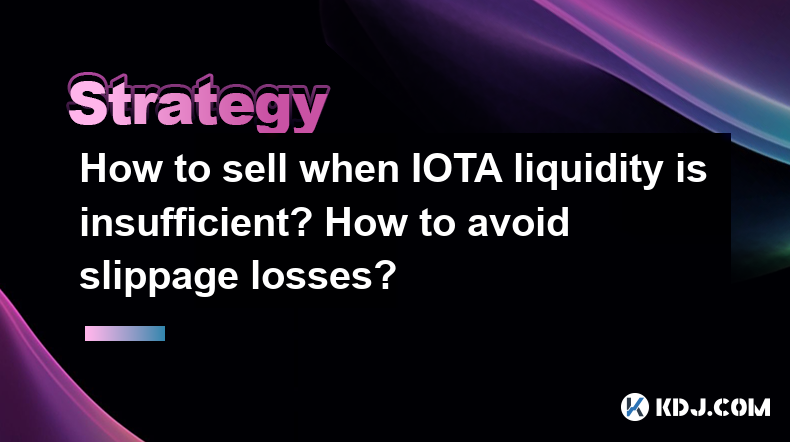
How to sell when IOTA liquidity is insufficient? How to avoid slippage losses?
Apr 30,2025 at 05:21pm
Understanding IOTA LiquidityWhen dealing with cryptocurrencies like IOTA, liquidity refers to how easily you can buy or sell the asset without affecting its market price significantly. Insufficient liquidity in IOTA can lead to challenges such as slippage, where the price at which your order is executed differs from the price you expected. This article ...
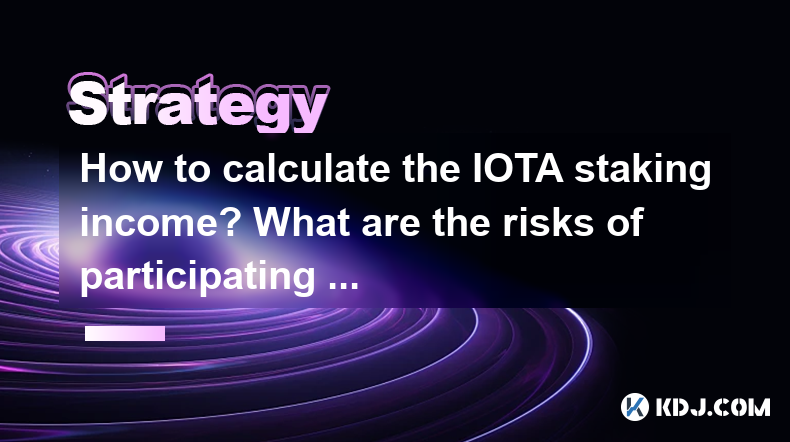
How to calculate the IOTA staking income? What are the risks of participating in staking?
Apr 30,2025 at 10:01pm
Introduction to IOTA StakingIOTA is a distributed ledger technology that enables feeless microtransactions and data integrity for the Internet of Things (IoT). Recently, IOTA introduced staking, allowing users to participate in network validation and earn rewards. Understanding how to calculate your potential income from IOTA staking and the associated ...
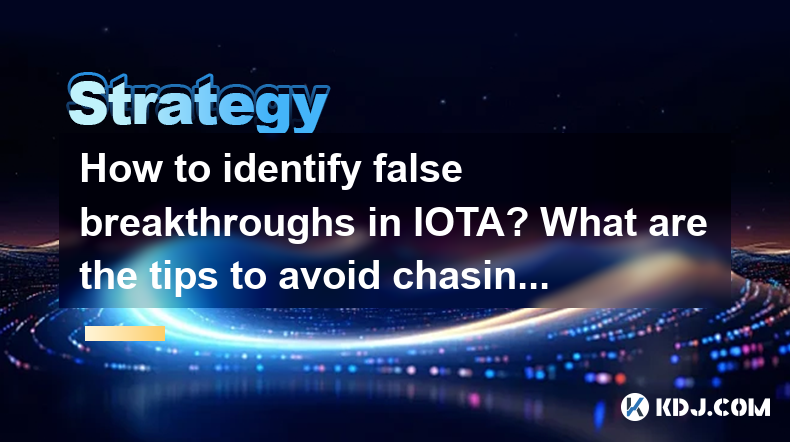
How to identify false breakthroughs in IOTA? What are the tips to avoid chasing ups and downs?
May 01,2025 at 08:15am
In the volatile world of cryptocurrencies, IOTA, like other digital assets, is prone to false breakthroughs that can mislead investors. Identifying these false signals and avoiding the pitfalls of chasing ups and downs are critical skills for any investor. This article will delve into the strategies to spot false breakthroughs in IOTA and provide tips t...
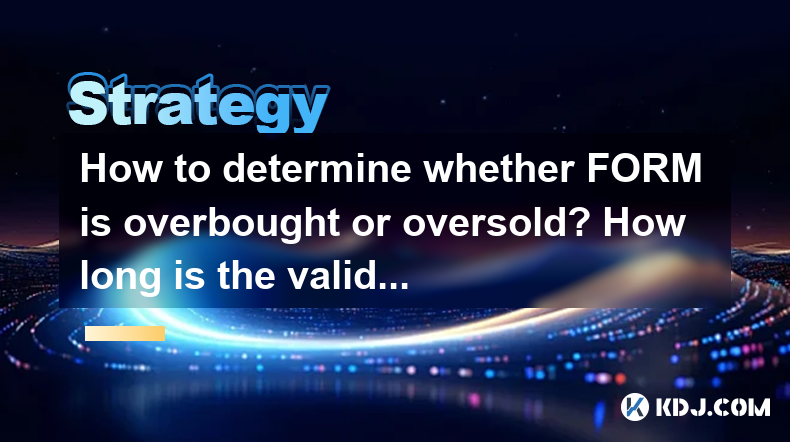
How to determine whether FORM is overbought or oversold? How long is the validity period of the RSI indicator?
May 01,2025 at 08:50pm
In the dynamic world of cryptocurrency trading, understanding the momentum and potential reversal points of a digital asset like FORM can be crucial for making informed trading decisions. Two popular tools for this purpose are the Relative Strength Index (RSI) and the concept of overbought and oversold conditions. In this article, we will delve into how...

What to do after the IOTA crash? Is it wiser to buy at the bottom or stop loss?
May 01,2025 at 08:43am
After experiencing a significant crash in the value of IOTA, investors and traders are often left wondering about the best course of action. The decision to buy at the bottom or implement a stop loss can be pivotal, and understanding the nuances of each strategy is essential for making informed decisions. This article delves into the various approaches ...

Is the IOTA trading robot easy to use? How to set up an automated strategy?
Apr 30,2025 at 09:21pm
Is the IOTA trading robot easy to use? How to set up an automated strategy? The world of cryptocurrency trading has seen significant advancements in automation, and one such tool is the IOTA trading robot. Many traders are curious about the ease of use of these robots and how to set up an automated strategy. This article will delve into these topics, pr...

How to sell when IOTA liquidity is insufficient? How to avoid slippage losses?
Apr 30,2025 at 05:21pm
Understanding IOTA LiquidityWhen dealing with cryptocurrencies like IOTA, liquidity refers to how easily you can buy or sell the asset without affecting its market price significantly. Insufficient liquidity in IOTA can lead to challenges such as slippage, where the price at which your order is executed differs from the price you expected. This article ...

How to calculate the IOTA staking income? What are the risks of participating in staking?
Apr 30,2025 at 10:01pm
Introduction to IOTA StakingIOTA is a distributed ledger technology that enables feeless microtransactions and data integrity for the Internet of Things (IoT). Recently, IOTA introduced staking, allowing users to participate in network validation and earn rewards. Understanding how to calculate your potential income from IOTA staking and the associated ...

How to identify false breakthroughs in IOTA? What are the tips to avoid chasing ups and downs?
May 01,2025 at 08:15am
In the volatile world of cryptocurrencies, IOTA, like other digital assets, is prone to false breakthroughs that can mislead investors. Identifying these false signals and avoiding the pitfalls of chasing ups and downs are critical skills for any investor. This article will delve into the strategies to spot false breakthroughs in IOTA and provide tips t...

How to determine whether FORM is overbought or oversold? How long is the validity period of the RSI indicator?
May 01,2025 at 08:50pm
In the dynamic world of cryptocurrency trading, understanding the momentum and potential reversal points of a digital asset like FORM can be crucial for making informed trading decisions. Two popular tools for this purpose are the Relative Strength Index (RSI) and the concept of overbought and oversold conditions. In this article, we will delve into how...
See all articles




















































































